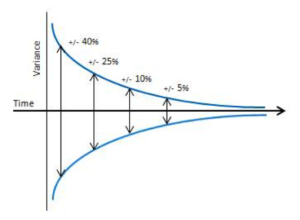The project schedule is the most recognized project management artifact. Stakeholders embrace the schedule as a sacred covenant with the team. In reality, project plans are just the best approximation of the future based on today’s limited knowledge and information.
“In planning for battle, I have always found that plans are useless, but planning is indispensable.” — General Dwight David Eisenhower
Project planning is a critical exercise. It clarifies what needs to be done, how long it may take, and in what general order. Planning also identifies the interdependencies between tasks, related projects, and external events.
The plan is commonly rendered as a Gantt chart. The detailed and intricate structure of most Gantt charts creates the impression of precision and accuracy. However, these expectations are often greater than their ability to deliver. The planning process makes critical assumptions:
- The project can be precisely decomposed into discrete, estimable, packets of work;
- The effort and time required for these tasks can be predicted well in advance; and
- Reality unfolds as planned.
This article complements my December 2014 post, 4-Ways to Shorten a Project Schedule and provides six additional ideas for improving the planning process.
Accept the Cone of Uncertainty
Contents
The Cone of Uncertainty is a framework that incorporates the unknown (uncertainty) into the planning and estimating process. It postulates that as projects progress, estimates become more accurate as more is known (see below). For example at inception, the estimate may only have an accuracy range of +/- 40%.
While the framework is well known, it is often not incorporated into portfolio and project funding processes. It is hard to create financial plans when a $10 million project may have an estimated range of $6-$14 million. Governance and finance organizations prefer greater certainty.

Two options for balancing the unknown with the desire for certainty include:
- Embrace agile principles of funding capacity. In this model, the cost and duration are set, but the scope is variable; and
- Establish a financial planning and governance process that incorporates periodic updates into the funding and estimating model.
Employ Progressive Elaboration Techniques
Progressive elaboration complements the cone of uncertainty and establishes a formal process where the cost and duration estimates are periodically updated. This reduces risk since new information is regularly incorporated.
To balance the effort spent on the updates with their incremental value, the updates should be made at regular intervals or at the completion of specific project phases, for example:
- Update plans and estimates quarterly;
- In a waterfall environment, updates could be done before the beginning of the next project phase;
- In an Agile environment, updates could be incorporated into the epic or feature planning process.
Plan at the Right Level of Detail
Most project plans are very detailed and complicated. Too much detail adds unnecessary complexity. Thoughtfully determining the right level of detail to plan and track performance is an important consideration.
Here are general guides to regulate the detail by bounding the duration of project tasks:
- Near-term tasks (next 1-3 months): no less than one or two days and no more than two weeks,
- Medium-term tasks (3-9 months): no less than a week and no more than a month,
- Long-term tasks may be expressed in months or quarters.
Constrain the Planning Process
Organizations often employ complex planning models or create overly detailed plans.
There is a body of research arguing that estimating methods such as COCOMO and Function Point Analysis do not improve accuracy. While the Analogy Method may provide better estimates, it requires a significant investment to develop the infrastructure.
Schedules where tasks are shown in too much detail do not improve precision. The detail complicates the alignment of dependencies, which tends to elongate schedules. They also require a significant level of effort to build and maintain.
Constraining the planning process can minimize the time and effort expended without sacrificing accuracy. After a certain point, there are diminishing returns from the additional effort. The process can be bound by:
- Time boxing the planning process; or
- Limiting the number of tasks in the project plan.
Include the Performers
Include the people who will execute the project in the planning process. The benefits from including the intended project team, includes:
- The team is best positioned to understand the project and its capabilities;
- Time will not be lost orienting the team to someone else’s plan, and
- The team will have ownership and buy-in.
Adopt the Project Box
In October 2015, I introduced the Project Box, which describes a framework where time is fixed, cost is a function of time, and scope is dependent on what can be built within these constraints. The Project Box describes an environment where fixed-sized teams deliver a prioritized pipeline of work.
This type of capacity based planning simplifies the estimating process. Resource levels are set and costs are highly predictable. Changes in the cost trajectory are based on explicit decisions to add or remove capacity.
Planning is important. Embrace the process and accept the limitations of the plan. The real value is derived from the critical thinking used to develop the plan. Recognizing that events change and effortlessly adapting to the new reality is the ultimate goal.
© 2016, Alan Zucker, Project Management Essentials, LLC.
Sources:
Cone of Uncertainty. (n.d.). Retrieved April 16, 2016, from https://en.wikipedia.org/wiki/Cone_of_Uncertainty
Niessink, F., & Van Viet, H. (1997, October). Predicting Maintenance Efforts with Function Points. Retrieved April 16, 2016, from http://www.cs.vu.nl/~hans/publications/y1997/ICSM97.pdf
Shepperd, M., Schofield, C., & Kitchenham, B. (1, May 1996). Effort estimation using analogy. Retrieved April 16, 2016, from http://dl.acm.org/citation.cfm?id=227758
Zucker, A. (2014, December 10). 4-Ways to Shorten a Project Schedule. Retrieved from https://www.linkedin.com/pulse/20141210012506-13706055-4-ways-to-shorten-a-project-schedule?trk=mp-reader-card
Zucker, A. (2015, October 31). The Project Box: Evolving Beyond the Triple Constraint. Retrieved April 16, 2016, from https://www.linkedin.com/pulse/project-boxevolving-beyond-triple-constraint-alan-zucker?trk=mp-reader-card


2 thoughts on “Planning is a Process, Not an Outcome”
Comments are closed.